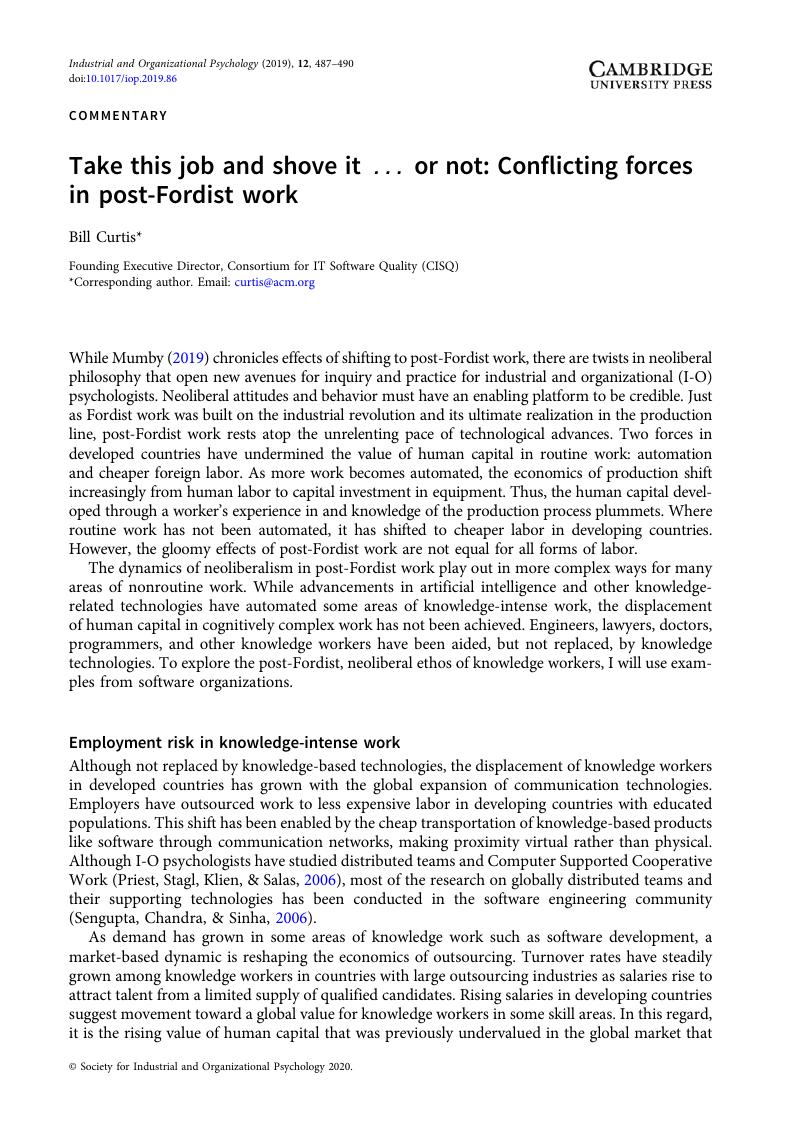No CrossRef data available.
Article contents
Take this job and shove it … or not: Conflicting forces in post-Fordist work
Published online by Cambridge University Press: 14 January 2020
Abstract
An abstract is not available for this content so a preview has been provided. Please use the Get access link above for information on how to access this content.

- Type
- Commentaries
- Information
- Copyright
- © Society for Industrial and Organizational Psychology 2020
References
Bosu, A., Greiler, M., & Bird, C. (2015). Characteristics of useful code reviews: An empirical study at Microsoft. In Di Penta, M., Pinzger, M., Robbes, R., Kamei, Y., & Ying, A. (Eds.), Proceedings of the Conference on Mining Software Repositories (pp. 146–156). Washington, DC: Institute of Electrical and Electronics Engineers.Google Scholar
Curtis, B., Krasner, H., & Iscoe, N. (1988). A field study of the software design process for large systems. Communications of the ACM, 31(11), 1268–1287.CrossRefGoogle Scholar
Hall, T., Sharp, H., Beecham, S., Baddoo, N., & Robinson, H. (2008). What do we know about developer motivation? IEEE Software, 25(4), 92–94.CrossRefGoogle Scholar
Mumby, D. K. (2019). Work: What is it good for? (Absolutely nothing)—a critical theorist’s perspective. Industrial and Organizational Psychology: Perspectives on Science and Practice, 12(4), 429–443.Google Scholar
Murthy, N. R. N. (2013, December 24). Has Narayana Murthy’s return at Infosys worked for the IT major? The Economic Times. Retrieved from https://economictimes.indiatimes.com/tech/ites/has-narayana-murthys-return-at-infosys-worked-for-the-it-major/articleshow/27845971.cmsGoogle Scholar
Piketty, T. (2014). Capital in the twenty-first century. Cambridge, MA: Belknap Press.CrossRefGoogle ScholarPubMed
Priest, H. A., Stagl, K. C., Klien, C., & Salas, E. (2006). Virtual teams: Creating context for distributed teamwork. In Bowers, C., Salas, E., & Jentsch, J., Creating high-tech teams (pp. 185–212). Washington, DC: American Psychological Association.Google Scholar
Schumpeter, J. (2008). Capitalism, socialism, and democracy. New York, NY: Harper Perennial Modern Classics.Google Scholar
Sengupta, B., Chandra, S., & Sinha, V. (2006). A research agenda for distributed software development. In Proceedings of the 28th International Conference on Software Engineering (pp. 731–740). New York, NY: Association for Computing Machinery.Google Scholar
Smite, D., & Solingen, R. V. (2016). What’s the true hourly cost of outsourcing? IEEE Software, 33(5), 60–69.CrossRefGoogle Scholar
Tan, L., & Hindle, A. (2019). Guest editorial: Special section on mining software repositories. Empirical Software Engineering, 24(3), 1458–1460.CrossRefGoogle Scholar
Vorhauser-Smith, S. (2012). How to stop employee turnover in India. Forbes. Retrieved from https://www.forbes.com/sites/sylviavorhausersmith/2012/07/02/how-to-stop-employee-turnover-in-india/#738533fb1481.Google Scholar


